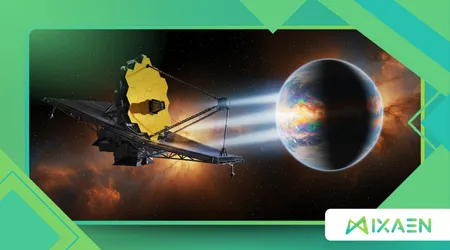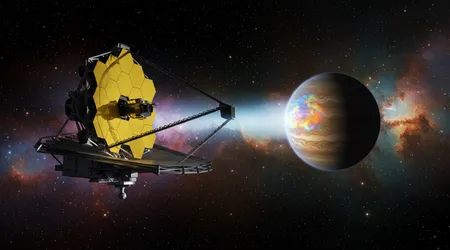The James Webb Telescope’s Hunt for Alien Atmospheres

The James Webb Telescope’s Hunt for Alien Atmospheres is one of the most exciting quests in modern science. We are at the cusp of a new era of discovery. We are moving from simply detecting exoplanets to analyzing their very air.
Anúncios
For decades, we could only guess at what lay beyond our solar system. The sheer number of exoplanets discovered is staggering. Now, we want to know what these distant worlds are made of.
The James Webb Space Telescope (JWST) is the most powerful tool for this task. Its infrared capabilities are revolutionary. It can peer through the dust and gas. It can analyze the light from distant stars.
This isn’t a search for little green men. It’s a methodical, scientific process. It’s about finding the building blocks of life. It’s about understanding our place in the universe.
The James Webb Telescope’s Hunt for Alien Atmospheres is based on a simple but brilliant method. It involves watching a planet pass in front of its star. This is called a transit.
When the planet transits, the starlight filters through its atmosphere. The atmosphere absorbs some of the light. This creates a unique spectral fingerprint. Scientists can analyze this fingerprint.
How Webb Deciphers Distant Worlds
Webb’s instruments are incredibly sensitive. They can detect the subtlest changes in starlight. This sensitivity is the key to its success.
The telescope uses spectroscopy to break down the light. Each element and molecule leaves a specific signature. Methane, water vapor, and carbon dioxide all have unique patterns.
This is the central pillar of the James Webb Telescope’s Hunt for Alien Atmospheres. It’s like a cosmic detective analyzing a clue. Each spectral line tells a part of the story.
++ How Ancient Earth May Resemble Life on Exoplanets Today
The telescope’s primary mirror is huge. Its size helps it collect more light. This allows it to study smaller, dimmer stars. It can even analyze rocky, Earth-sized planets.
For example, Webb recently confirmed the presence of carbon dioxide on an exoplanet. This was a major milestone. It proves the telescope’s incredible capability.
This is the first time we have seen a definitive signal of carbon dioxide. The discovery was a huge step forward. It shows we can detect complex molecules.
The James Webb Telescope’s Hunt for Alien Atmospheres isn’t just about finding life. It’s about understanding planetary formation. It’s about learning how planets evolve over time.

Biosignatures and the Search for Life
The ultimate goal of this mission is to find biosignatures. These are chemical compounds that suggest the presence of life. Oxygen and methane are prime examples.
Methane on Earth is produced by living organisms. If we find both methane and oxygen together, it would be a very strong signal. It would be a strong hint of life.
The James Webb Telescope’s Hunt for Alien Atmospheres is a slow, methodical process. There are no quick answers. It takes time to collect enough data.
The search is a massive undertaking. It involves scientists from around the world. They work together to analyze the data. This is a global effort.
Also read: Could Gas Giants Like Jupiter Hide Floating Ecosystems?
Think of it like trying to identify a single musical note in a symphony. The note is the biosignature. The symphony is the light from the star. Webb is the instrument that can isolate that single note.
A 2025 study from NASA’s Goddard Space Flight Center projected Webb’s capabilities.
It stated that within the next five years, Webb could likely identify biosignatures on at least a dozen promising exoplanets. This is a huge increase in our potential for discovery.
Read more: Are We Looking for Alien Life in the Wrong Way?
The science is still in its early stages. But the potential is enormous. The James Webb Telescope’s Hunt for Alien Atmospheres is already delivering on its promises.
| Molecules Searched For | Possible Origins | Relevance to Life |
| Water Vapor (H2O) | Volcanism, Geologic Activity | Essential for all known life forms |
| Carbon Dioxide (CO2) | Volcanism, Biological Processes | A key component of Earth’s atmosphere |
| Methane (CH4) | Geologic Activity, Microbial Life | Can be a strong biosignature |
| Oxygen (O2) | Photosynthesis, Geologic Processes | A very strong biosignature for complex life |
This table shows the primary targets for Webb’s analysis. Each molecule provides a different piece of the puzzle.
The Future of Exoplanet Exploration
The James Webb Telescope’s Hunt for Alien Atmospheres is just the beginning. The data it collects will guide future missions. It will help us decide where to look next.
The next generation of telescopes will be even more powerful. They will be able to perform even more detailed analyses. They will build on Webb’s foundation.
Webb’s discoveries are already shaping our understanding of planetary science. We are learning how diverse these distant worlds are. Some are giant gas balls, others are rocky super-Earths.
The question that remains is: Are we alone in the universe? Webb might not answer it directly. But it will give us the strongest clues yet. It will bring us closer to an answer.
The search for life is a timeless human quest. It is a fundamental question. Webb is giving us the tools to finally start answering it. What an amazing time to be alive.
Frequently Asked Questions
1. What is an exoplanet’s atmosphere?
An exoplanet’s atmosphere is the layer of gases surrounding it. Studying these gases helps scientists understand the planet’s climate, composition, and potential to host life.
2. How does Webb study an atmosphere from millions of miles away?
Webb uses a method called transit spectroscopy. When an exoplanet passes in front of its star, the starlight shines through its atmosphere. Webb’s instruments analyze the light that passes through, identifying which molecules are present by their unique light signatures.
3. What is a “biosignature”?
A biosignature is a substance, like a gas or a chemical compound, that provides strong evidence for the past or present existence of life. On Earth, oxygen and methane in our atmosphere are strong biosignatures.
4. Can Webb definitively prove that life exists on an exoplanet?
Webb cannot provide definitive proof of life. It can only detect the chemical signatures of potential biosignatures. While a combination of certain gases would be a strong indication, confirming life would require future missions and more direct evidence.
5. How does Webb’s infrared capability help in this search?
Infrared light is essential because it can penetrate through dust clouds and nebulae. More importantly, many of the key molecules we are searching for, such as water and methane, have strong spectral signatures in the infrared spectrum, which Webb is designed to detect.
